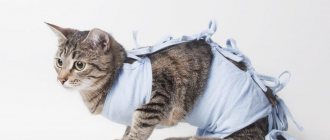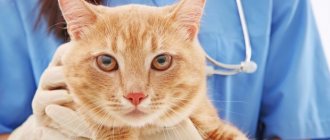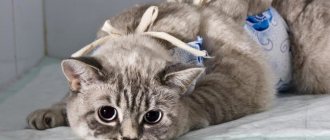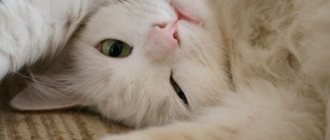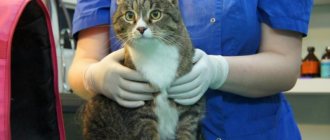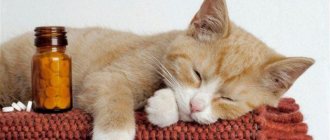Surgery is often the only effective method aimed at curing many diseases. Surgical sterilization of cats, castration of cats and other important interventions are of great importance. Imagine - the operation was successful, the animal feels good and runs around, but... you need to remove the stitches. How to do this without harming the animal along the way?
The difference between sterilization and castration in cats
The first thing I would like to find out is whether you understand the essence of the operation correctly.
Many people perceive the terms “sterilization” and “castration” as one and the same, only the first is applicable for cats, the second for cats. However, this is not entirely true. In fact, both castration and sterilization can be performed on both males and females. The fundamental difference is that after sterilization, the animal retains its sexual behavior, whereas after castration, sex hormones cease to make themselves felt.
Despite the fact that this operation is completely safe for the animal, simple and standard for specialists, its technique has long been worked out; this is a serious procedure for your pet, for which you need to prepare and after which you must follow a special regime.
How to remove stitches from a cat yourself after sterilization: step-by-step instructions
In recent years, cat lovers are increasingly resorting to sterilization of their pets, and this is very good, since the operation can significantly reduce the number of stray animals.
But in order for everything to be fine with the cat after the procedure, you need to know at least the basic rules for caring for it.
For example, about how to remove stitches from a cat yourself: a veterinarian is not always nearby, and almost anyone can cope with this operation.
It all depends on the specific case. The condition of the postoperative wound plays a huge role.
By the time the suture material is removed, it must meet the following requirements:
- The cut line may be rough, the stitches of the sutures are clearly visible, but the presence of bloody discharge, blood crusts or exudate is unacceptable.
- You need to feel the seam. If everything is in order and the suture material can be removed, then the local temperature will be normal.
- Swelling and redness of the postoperative wound are also unacceptable.
As a rule, the suture reaches this state by the tenth day after surgery, in some cases you have to wait two or three weeks (this does not happen often).
How many days after endoscopic surgery can the suture be removed? The suture is rarely longer than five millimeters; there is no need to rush to remove it. Haste can leave the animal's abdominal cavity open to bacterial contamination.
Here everything depends on the characteristics of the suture material used during the operation. Today, veterinarians all over the world are trying to use varieties that dissolve on their own. But this doesn't always happen.
Many veterinary specialists clearly answer that sutures should be removed regardless of the suture material used.
This will save you from many problems in the future. Please note that this only applies to external seams. Sutures placed on the peritoneum dissolve perfectly.
Yes, this is quite possible. Moreover, it is at home that sutures are usually removed. As a rule, there is no need to take the cat to the clinic for this procedure, since all the necessary manipulations can be performed independently without any problems.
For everything to go well, you need to prepare the following things:
- A stable and fairly stable table with a flat surface.
- Oilcloth and several diapers.
- Sharp nail scissors and tweezers.
- Alcohol tincture of iodine or brilliant green.
Most likely, everything you need can be found in any home without any problems; no special devices are required for removing sutures.
First you need to assess the “mental state” of your pet. If for some reason the cat shows nervousness or aggression, then it is better to wait until the stitches are removed or consult a veterinarian.
Perhaps a specialist will be able to recommend some mild sedatives that have a calming effect. With their help, it will be much easier to remove stitches even in an easily excitable and aggressive cat.
Preparation is carried out as follows:
- First you need to take care of good lighting. Working in semi-darkness is not a good idea. It is advisable that the lighting be from above: in this case there will be fewer shadows and the task of removing seams will be easier.
- If the cat is a representative of long-haired breeds, it is necessary to trim off the excess fur covering the seam line. The less hair there is, the less likely it is that hairs will get into the wrong place.
- At the same time, boil the scissors and tweezers that will be used to remove the suture material thoroughly (for at least half an hour). If it is impossible to boil the instruments for some reason, you should at least wash them with warm water and soap (or wipe them thoroughly with medical alcohol).
- After this, wipe the seam line with warm soapy water. This is necessary to remove dirt and pieces of fur from the animal’s skin. In addition, after treatment the seams will soften somewhat, making them much easier to remove.
Here are step-by-step instructions that must be strictly followed when removing suture material:
- Before starting work, you need to wait about ten minutes so that the soapy water, which we already talked about above, has time to soften the suture material.
- After this, you must definitely count how many stitches were placed. If possible, you should also call the veterinarian who performed the spay and ask how many stitches he used. This is necessary so as not to accidentally leave a couple of stitches. This, by the way, does not happen so rarely.
- You can start withdrawing. First, you need to thoroughly wipe the tweezers with alcohol, and then carefully grab the seam loop. It should be pulled upward as much as possible.
- As soon as the seam has stretched sufficiently, you need to insert the lower jaw of the scissors under it and cut the thread.
- To remove the remainder of the latter, you need to pull it out of the skin. This is done carefully and without unnecessary haste. If the thread is “stuck” to the skin, it is necessary to carefully turn it around its axis and pull the rest of the seam towards you. If you pull too hard, you can injure your cat, tearing the thin layer of newly healed skin.
If the seam does not give way, and a piece of thread comes out of the skin with great difficulty, there is no need to rush and tear it out “forcibly”. You can wipe the grout line again with warm soapy water and wait about an hour. After this period, the skin will soften, after which everything can be done without much effort.
In order not to endanger the life and health of the cat, the owner who decides to remove the stitches himself must strictly follow the safety rules below:
- It is not recommended to remove stitches unless they have been examined by a veterinarian first. Only an experienced specialist will be able to tell how well the postoperative wound has healed and how safe it will be to remove the suture material.
- It is forbidden to remove sutures if the suture line is “inflated”, inflamed, numerous areas of redness are observed, and the local temperature in these places is significantly increased. These signs indicate a strong inflammatory response. In such cases, you should call your veterinarian immediately.
- In cases where there is bleeding (even a drop), or the release of exudate (regardless of the volume of the latter), the sutures are also prohibited from being removed.
We suggest you read: Kidney failure in cats: causes and treatment
Remember! Even if none of the above is observed, but the cat is behaving strangely and nervously, it is better to have it examined by a veterinarian first.
During the procedure, the owner should worry not only about the safety of his pet. The health of the person undergoing the suture removal procedure may also be at risk. This is due to the fact that cats are rarely delighted with the fact that someone is “poking” their skin with tongs.
If possible, call your veterinarian. The specialist may recommend some mild sedatives. Under their influence, the animal will become calmer, and therefore it will be easier for the owner to cope with it.
However, you can cope without “chemistry”, but this will require an assistant. Just remember that you will have to hold the animal quite firmly.
The situation when the cat removed the stitches itself is not uncommon in veterinary practice. Unfortunately, nothing good should be expected from such initiative, but there is still a chance for a successful outcome. They increase if the animal has its stitches removed closer to the date of their “official” removal.
If this happened in the first days after the operation, then the owner does not have much choice: he needs to urgently call the veterinarian.
The following signs indicate a high probability of severe complications:
- Heavy bleeding.
- Torn, torn edges of a postoperative wound.
- Easily visible internal organs visible through the disturbed wound channel.
Let us repeat once again - in such cases you need to immediately call a veterinarian. If the bleeding is severe, it is necessary to take the cat to the nearest clinic, but we would recommend waiting for a specialist at home. Transporting a cat with such injuries is very dangerous, and the pet may simply not survive until medical attention is provided.
Sterilization involves removing sutures after surgery on a cat, unless it is laparoscopy. Sutures are usually placed using two methods - internal and external. The internal connects the cut tissues inside (muscles, subcutaneous fat, etc.), and the vessels are also ligated. It is performed with special self-absorbing threads that do not require removal.
An experienced veterinarian pays the greatest attention to the quality of internal sutures, since the condition of the animal after surgery directly depends on this. External sutures are usually performed with surgical sutures, in which case it will be necessary to remove the sutures after a certain time. In addition to removing stitches immediately after surgery, the cat will also need rehabilitation.
Safety precautions for the pet owner
During the procedure, the owner should worry not only about the safety of his pet. The health of the person undergoing the suture removal procedure may also be at risk. This is due to the fact that cats are rarely delighted with the fact that someone is “poking” their skin with tongs.
As a rule, removing stitches is not the most pleasant procedure; severe discomfort is possible. To minimize the likelihood that your pet will tear your hands until they bleed, you need to take the following steps:
If possible, call your veterinarian. The specialist may recommend some mild sedatives. Under their influence, the animal will become calmer, and therefore it will be easier for the owner to cope with it.
Please note that cat sterilization itself can be carried out using the same medications. If you reintroduce them a few days after the operation, the animal’s body will have a very hard time (the so-called cumulative effect will play a role). Thus, in this case it is necessary to select other sedatives. This will avoid unpleasant consequences.
However, you can cope without “chemistry”, but this will require an assistant. Just remember that you will have to hold the animal quite firmly.
Preparing for surgery
To minimize risks, the cat must be checked, undergo the necessary tests, and, if everything is in order, prepared for surgery.
Since cat spaying is an operation that is done under general anesthesia, it is best to schedule it in the morning so that you can keep an eye on your cat while she recovers from the anesthesia, which will take several hours. Prepare in advance the place where you will place the cat after the operation, and the basket with which you will bring the cat home.
The cat will tolerate anesthesia more easily on an empty stomach, so 12 hours before the operation it is necessary to put the cat on a forced hunger strike. You need to take this seriously: a hunger strike will help avoid vomiting during surgery and reduce the load on the animal’s heart. Get your pet's stomach to empty; consult your veterinarian about how to do this. The cat can be given something to drink 3 hours before surgery.
Is it possible to feed and water a cat?
It is necessary to give your cat water, as this restores the water balance, especially during surgery, when the animal’s throat and mouth often dry out. For the first few hours, it is worth moistening the mouth with a cloth, and then placing a bowl of water at room temperature near the pet so that he has access to it at any time.
But it is not advisable to feed on the first day, it is a heavy burden on the body. Even if the poor animal meows and asks for food, it is better not to do this, since the intestines may not be able to withstand it, and the cat will vomit. Food should be introduced gradually from the second day, and always light and in small quantities.
Important! Regarding nutrition, it is better to consult with a veterinarian; he should know what food is safe and most beneficial for the pet during the postoperative period.
Special food is suitable for feeding
Rules for rehabilitation after sterilization
After sterilization of the cat, during the normal healing process, the sutures are removed on days 10-14. Until this time, the pet requires careful care. The rules differ slightly depending on the options for the post-rehabilitation period. The veterinary clinic offers several such options:
- the owner takes the animal home immediately after sterilization and carries out the necessary manipulations there;
- the cat remains in the veterinary clinic for a day;
- the pet remains in the hospital for a period of about 10 days to fully recover after the operation.
Of course, it is more convenient for the owner and safer for the animal when the postoperative period takes place under the supervision of a veterinarian in the clinic. If you decide to pick up your cat right away, you will need a spacious carrier with a hard floor. It is better to have one with an open top so that the pet can be carefully placed instead of being pushed inside.
At home, it is necessary to provide the animal with complete peace in a secluded, safe place. After anesthesia, the body temperature usually drops, and the cat may freeze. In this case, it must be covered. Be sure to put water nearby. Until the cat recovers from anesthesia, it should be turned from side to side. And just as often, close your eyelids to prevent the cornea from drying out, since cats have open eyelids during anesthesia (this is their feature).
When the cat begins to recover from anesthesia, you should take care of its safety - close balconies, vents, windows, because behavior may be inappropriate. How the pet will behave depends on its character traits - some may bite and behave aggressively, while others may hardly move and sleep most of the time.
During this period, you should carefully monitor the animal and prevent it from harming itself. The blanket should not be removed under any circumstances to prevent licking of the seam! The cat will be able to move normally after some time (from 4 to 12 hours). It is necessary to give water on the first day after surgery; feeding can be postponed, especially if after trying to eat the pet starts vomiting.
In the first three days after surgery, the cat is given antibiotics and painkillers. After stopping pain medications, behavior may change due to pain in the suture area. If it is too strong, the animal may lie motionless, moan, behave aggressively, and the pupils may be dilated. In this case, the help of a veterinarian is urgently needed.
Throughout the postoperative period, you need to monitor the blanket - how it is tied, whether it is clean or not. It is important to adjust your diet and monitor your drinking regime. You can carefully pick up the cat in your arms, making sure there is no pressure on the stomach. You can take her for walks, but only if the animal does not experience stress from possible encounters with other animals.
If you follow all the necessary rules for the postoperative period, as well as the veterinarian’s recommendations, the cat’s rehabilitation will be successful.
Caring for your cat in the first 7 days after surgery
The operation lasts about half an hour, after which you can take your pet home. After surgery, you need to treat your pet with special care. The basic rule is not a drop of cold. Wrap the cat in a blanket and transport it in a well-warmed car. Under anesthesia, a cat may urinate involuntarily, so prepare a moisture-absorbing diaper and do not allow the animal to become overcooled in the slightest.
We suggest you read: How to properly feed a sterilized cat with natural food. We figure out how and what to feed a sterilized cat
During recovery from anesthesia (2-3 hours after surgery), it is important to strictly adhere to the following rules:
- Keep the animal warm.
- Don't let your cat go up on high ground.
- Don't let the cat out of your sight.
- Force your cat to blink.
It is important to know that during anesthesia the animal does not blink, which causes the mucous membrane of the eye to begin to dry out. Therefore, we must make them “blink” forcibly. “Close” the animal’s eyes, using your fingers to help, or apply moisturizer to the eyes.
Don't let the cat disappear from sight; keep an eye on it constantly. When coming out of anesthesia, she may behave unusually, she needs help and peace. Try to lay on your right side.
It is important to understand that proper care for a cat after sterilization is not only help in coming out of anesthesia, but also 7 days of the strictest postoperative regime.
After the operation, you need to be with your cat. She will sleep more than usual, after anesthesia she will be lethargic, and when coming out of anesthesia she may behave differently: her coordination of movements may be impaired, and hallucinations are possible.
On the first day, avoid sudden movements towards the cat and do not allow her to make them. Under no circumstances allow your cat to play actively, and do not allow other animals near it. If the operation is performed on a nursing cat, which is extremely rare, do not allow kittens near her. Be prepared for the animal's involuntary urination and unpredictable movements. Vomiting is possible (before vomiting, the cat usually actively and excessively licks its face).
Get the cat to go to the toilet. If the cat goes to the toilet on its own, accompany it and provide assistance. To do this, place a towel under her stomach - this will help her empty her stomach and increase stability.
You cannot feed your cat on the day of surgery. This will not be difficult to achieve, since the cat will have no appetite on the first day.
It is necessary to give water to the cat by holding its head over a bowl or by drip, using a syringe or pipette. Start giving water as soon as the cat begins to recover from anesthesia.
Most likely your cat will need to be given pain medication.
Basic rules of the first day:
- Avoid active movements.
- Don't feed.
- Forced drinking.
- Do not allow the cornea to dry out.
- Ensure emptying.
On the second day, you need to start feeding the cat. Feed in reduced quantities. Food during the day should be about three times less than usual. Start with small portions. Food should be light and low-fat. You can start with broth, baby meat food, even if your cat is only on dry food.
On the second day, the cat should drink on its own.
Bathing is prohibited in the first weeks after surgery until the suture heals.
On the second day after sterilization, the cat is less lethargic and behaves more adequately. Keep an eye on her and continue to help her come to her senses. If she is still weak and her paws are cool, rub her paws and make sure she is not freezing. Don't let your cat wander too far. It is better to place the toilet nearby.
If on the second day the cat did not go to the toilet or start walking, observe its behavior and consult a doctor.
On the second day you may still need pain medication, but usually this is the last day: the pain after surgery disappears within the first two days.
The third day
On the third day, the cat should already come to its senses and begin to behave as usual. She should already be interested in nutrition on her own, and do this without constant help, but remember that after sterilization you should not overfeed, sterilized cats must be protected from obesity.
On the third day, the temperature should return to normal. Measure your temperature twice a day and if it is low or high, contact your doctor.
Monitor your bowel movements. If your cat does not go to the toilet, tell your doctor.
The cat's urination and bowel movements should be completely normal on the fourth day after surgery. The active mode should return to normal. If this does not happen, this is a reason to contact a veterinarian.
However, on this day it is better to leave the cat in a separate room under supervision.
Fifth day
On the fifth day, the cat can already be released from the room, allowed to walk and jump.
Inspect the seam. By the fifth day, signs of scarring should begin to appear and swelling should subside.
By the end of the week the cat should be completely back to normal. She can run, jump, eat, and go to the toilet as usual. The only thing that reminds you of the surgery was the bandage and the presence of stitches. The suture should be without signs of suppuration or inflammation. Usually on the seventh day the stitches can be removed.
Features of processing and removal of seams
When the scar heals, the wound is very itchy. Therefore, the cat tries to rid itself of discomfort with its claws and teeth. Sometimes it can even lead to the need for repeated surgery. Therefore, the seam is protected with a special blanket. It should not be removed, even if the owner thinks that the cat is uncomfortable and cannot move. You just need to make sure that the blanket is put on correctly.
It is important to ensure that the seam is clean and dry; any deviation (inflammation, suppuration, etc.) requires immediate medical attention. Usually the seams are treated every day with special disinfecting solutions. The main thing is that they do not contain alcohol, because... it may cause skin burns. Another option is when the incision site is treated with a special spray immediately after the operation, then the veterinarian usually reports that additional treatment is no longer required. In this case, all that remains is to monitor the pet’s condition and the healing process.
It happens that the seam comes apart after sterilization. The reasons may vary. One of them is that the wound got infected, despite all the precautions. Or, due to careless handling of the animal, excessive pressure was placed on the operated area (this problem can also arise due to a bandage that is too tight or an incorrectly applied blanket).
Another possible reason is the general condition of the body - weakened immunity, lack of vitamins, or some hidden disease that was not identified before surgery (for example, kidney disease, cough, malignant neoplasms, etc.). If the seam breaks, it is necessary to treat it with antiseptic drugs and urgently go to the veterinary clinic! In this case, you should not self-medicate, it is detrimental to your pet!
Removal of sutures after sterilization of a cat during the normal healing process is carried out on the 10-14th day. If this process is delayed, they begin to grow into the skin, which leads to additional unpleasant procedures. It is best for this manipulation to be performed by a veterinarian in the clinic. Or you can also call him at home.
We suggest you read: Names of aquarium fish, choosing pets for the aquarium
If you decide to remove the stitches yourself, you need to make sure that the wound has completely healed. The scar should be dry, without redness, without bloody spots, crusts, and the edges of the wound should not be visible. You should also pay attention to ensure that there is no swelling. If anything in the appearance of the wound worries you, it is better to show the animal to a veterinarian. Only a specialist can determine exactly how things are going with healing. If everything is in order, you should prepare the following necessary items:
- paper towel (or clean damp rag), dressings;
- good tweezers (to make it easy to grab threads), sharp scissors, preferably manicure scissors, with very thin edges;
- take care of good lighting;
- means for treating the wound after the procedure;
- a piece of something tasty to relieve your pet of the stress from the withdrawal process.
The first step before the procedure is to disinfect all instruments. Then soak the scar with saline solution (chlorhexidine can be used) so that the threads become soft. Another tip is to smear the seam several times with a greasy ointment the day before the removal procedure - this will make the threads smoother and easier to slide.
Now you need to secure the cat. It’s better to call someone else to help her so that she can hold her paws. Manipulations should be carried out quietly; the animal may be frightened even by the sight of tools in your hands. The seam consists of 2 parts - external and internal. On the outside it is a knot with the ends of the thread sticking out. The inner part is under the skin and is not visible to you.
To remove a seam, you need to pick up either a tendril or a knot and lightly pull up so that a clean part of the thread from the seam appears. Then cut off one (and only one!) thread that comes out of the skin. Cut so that the dirty outer edge of the thread does not pass through when pulled out through the wound. Otherwise, an infection can be introduced there.
The procedure for removing sutures is not that complicated, but it is responsible. If something suddenly goes wrong, you are not sure about something, leave everything and contact your veterinarian immediately! There is no point in risking the health of your pet, especially since the procedure for removing sutures in a clinic is more than affordable. It is also possible to call a veterinarian at home, which is convenient for the owner and less stressful for the cat.
How long does it take for internal sutures to dissolve?
Modern veterinary clinics use special suture material to create internal scars, which can dissolve on its own. That is, in theory, removing the threads located under the skin is not required. But in practice, their resorption does not always occur. If a cat undergoes a second operation after a few years, specialists sometimes find encapsulated old suture material. It does not cause any trouble or inconvenience to the animal, so there is no need to remove it.
Possible complications after surgery
It is important to distinguish between normal and cause for concern. How do you understand that something has gone wrong and you need to urgently call a doctor? We list the main possible complications and recommendations on what should be done in each case.
It takes a long time for a cat to recover from anesthesia. If the cat does not get up for the second day, its paws are cool, the temperature is low (below 37) - it’s time to be alarmed. Massage the paws, put him in a warm place, cover him warmly and report the problem to the veterinarian.
Bleeding. If traces of blood are detected in the area of the suture or vulva - there is a risk of intra-abdominal bleeding - the cat must be urgently taken to a veterinary hospital for repeated surgery.
Fever. If a cat has a high temperature (above 39) this is also a cause for concern. You should contact your doctor.
Swelling, redness, signs of rotting around the seam. These are all symptoms of infection and disruption of the healing process. Redness is possible in the first 3-5 days, but if the phenomenon continues to be observed on the 6th day, you should be alarmed.
Rotting can occur due to poor hygiene and irregular treatment of seams with an antibacterial agent. If this happens, further surgery may be necessary.
Growth, swelling in the suture area. If you notice the appearance of a lump in the suture area, this is also a reason to consult a doctor.
Seam processing
Experts recommend treating the seam about twice a day. If there is no large accumulation of discharge or ichor, you can limit yourself to one time. One way or another, it is better to carry out the treatment in the morning and evening. For convenience, it is better to process the seam together with a partner (friend, family member).
ATTENTION! The first check should take place three to four days after arrival from the clinic. This period is average for most cats. The characteristics of immunity and the ability to heal vary greatly in each specific case.
Periodic checks should be given special attention. Let's take a step-by-step look at the seam processing process:
- First, dip a cotton swab or disk into a bowl of antiseptic. Then carefully, without sudden movements, with light strokes we wipe the edges of the wound, freeing them from secretions and possible dirt.
- The seam itself is processed only as a last resort when there is a lot of contamination. As a rule, this happens when healing does not proceed properly and the help of a specialist is required. If such a situation occurs, it is recommended to apply disinfectants directly to the seam. Rubbing is not allowed.
- On the contrary, the skin around the seam should be washed especially thoroughly. Postoperative areas are more susceptible to infection by pathogenic microorganisms.
There is an opinion that it is better to treat a cat's wound while she is standing. This is due to safety reasons: the animal is protected from excessive penetration of the antiseptic into the seam.
What is unacceptable to do after sterilization
The cause of complications may be improper handling of the cat after surgery. Therefore, remember the main taboos and treat them responsibly.
So, in the first week after surgery:
- Do not pull the cat's front paws.
- Don't touch your stomach.
- Do not play outdoor games with your cat.
- Don't force you to eat on the first day.
- Do not remove stitches yourself.
- Don't let your cat get into the dirt.
- Don't let him near the heater.
- Do not lubricate the seams with brilliant green or iodine.
Sterilization is a simple operation, but only if all necessary measures are strictly followed. Otherwise, a standard operation may develop into a serious problem with complications. Help your pet cope with the postoperative period and contact your doctor if there is any deviation from the norm.
Whatever the sterilization method, the operating methods themselves are of the following types:
With a side cut.
This method is less painful for the pet, including for subsequent healing, the fact is that such an incision is smaller in size than the usual - classic one. True, with a side incision, despite all the advantages, it is not always possible to remove the entire reproductive organ.
Classic method.
The method is taught in universities, old and time-tested, usually all veterinarians know it. With the classical method, an incision is made along the so-called white line of the abdomen, the method is traumatic, since the incision is quite large; with this scheme, removing internal organs is not so difficult due to the size of the suture.
Laparoscopic method.
With this method, a laparoscope is used, which is inserted through a puncture in the animal’s skin; the veterinarian, guided by the image on the screen, removes the uterus and ovaries. With this method, there is no stitch and virtually no postoperative care. The main disadvantage of this method is that it is quite expensive compared to other methods of sterilization operations.
Any surgical intervention, whether animal or human, is accompanied by suturing. Postoperative sutures can be both external and internal.
It is important to know: If we are talking about an internal suture, then this is a long absorbable thread, the suture is continuous and takes a long time to dissolve. Internal sutures are placed on the body of the uterus, ovaries, abdominal muscles, and subcutaneous tissue. In the case of an internal suture, a return visit to the veterinarian is not required because there is no need to remove the sutures. External suture, a suture made from a thread that does not dissolve. Such a thread can remain with the body for a long time. External sutures are usually removed 2 weeks after surgery. There are also cosmetic stitches, such stitches are applied in a certain way using thread that dissolves.
The quality of the suture is the key to the pet’s health; if the suture is not applied well, it is the veterinarian’s fault, and such unprofessionalism can lead to various complications for the pet, including irreparable ones. Therefore, we recommend choosing a veterinary clinic with the utmost care.
How to process seams
It is very important to keep the seams clean and prevent infection and inflammation.
The bandage should be changed to a clean one every day, and the seam should be treated daily with the antibacterial agent “Argumistin”, which will prevent inflammation, fungus, and infection with microbes during periods of particular danger. The use of "Argumistin" has a number of advantages:
- eliminates the main cause of the disease;
- has an anti-inflammatory effect;
- activates the regeneration process;
- does not contain antibiotics;
- does not cause addiction in cats;
- ease of use;
- optimal price.
Monitor the progress of healing, treat the sutures daily, and in case of the slightest deviation, consult a doctor. The sooner complications are detected, the easier it is to prevent possible danger.
Conjunctivitis in dogs
Endometritis in dogs
Diabetes mellitus in cats
Endometritis in cats
How to process seams
It is very important to keep the seams clean and prevent infection and inflammation. The bandage should be changed to a clean one every day, and the seam should be treated daily with the antibacterial agent “Argumistin”, which will prevent inflammation, fungus, and infection with microbes during periods of particular danger.
The use of "Argumistin" has a number of advantages:
- eliminates the main cause of the disease;
- has an anti-inflammatory effect;
- activates the regeneration process;
- does not contain antibiotics;
- does not cause addiction in cats;
- ease of use;
- optimal price.
Monitor the progress of healing, treat the sutures daily, and in case of the slightest deviation, consult a doctor. The sooner complications are detected, the easier it is to prevent possible danger.
Do's, Don'ts and Don'ts
The owner needs to monitor the general condition of his pet.
The owner of a cat is often lost and does not always understand what is allowed and what is prohibited.
Can
The animal is not sick, but a minor operation, only a temporary deterioration in health.
Can:
- take your pet in your arms (do not put pressure on the stomach, picking it up under the hind and front paws);
- take him for short walks;
- give water without restrictions;
- provide food for sterilized cats.
Attention and moderate activity speed up rehabilitation.
Need to
To prevent possible complications it is necessary:
- keep the blanket clean;
- treat the postoperative wound daily;
- control the amount of food eaten (sterilized animals are prone to obesity).
It is necessary to take care of the eyes and ears, treat the fur from parasites, and remove tangles.
It is forbidden
Until the sutures are completely healed, it is prohibited:
- pick up the pet, picking it up under the belly;
- allow the animal to sleep on the radiator;
- allow active movement (first week);
- remove the bandage until the postoperative wound heals;
- leave a lot of food (portions should be measured).

